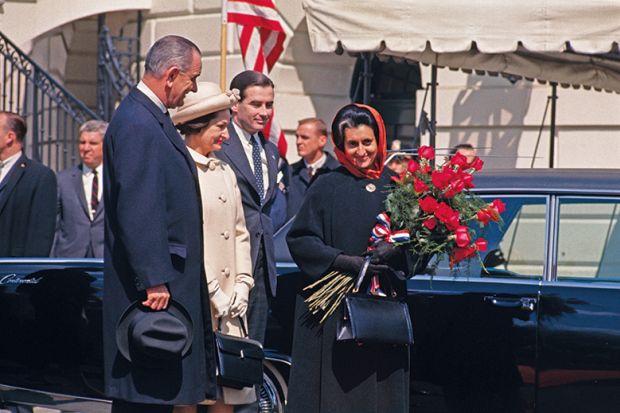In the so-deemed “developed” world – a term that largely, although not exclusively, refers to the liberal democratic polities of the geopolitical West – “foreign aid” is frequently a political football. It can be used to charge opponents with profligacy and inattention to local problems or to suggest that some recipient states are undeserving of assistance.
Rarely, though, is the idea of “aid” itself questioned: the assumption remains that it is largely altruistic, motivated by conscience, benevolence or concern about gaping economic inequality. The debates, such as they are, largely turn on whether aid is necessary and how much should be given. We seldom see critical scrutiny directed at the ideological underpinnings of the very idea of “aid”, the giving and taking of which creates a relationship in which one party is necessarily figured as active and benevolent, the other as relatively passive and inevitably somewhat backward if nonetheless “developing” into some unspecified state of grace.
There is, of course, nothing remotely apolitical or ideology-free about aid as a concept and as a project. Along with the very idea of “development”, it has become one of the most ideological and politically charged planks of post-Second World War geopolitics as former colonial powers and emergent superpowers fought to divide the decolonising world into spheres of influence.
In The Price of Aid, David Engerman explores aid as a “front” in the unfolding Cold War that turned post-independence India into the terrain of a dramatic ideological contest between the US and the USSR, between the buccaneering free-market capitalism of the former and the already deeply compromised version of communism espoused by the latter. Shaped, of course, by the internal politics of both superpowers, “aid” became weaponised – at times, literally so, involving military deals. The newly post-colonial nation’s own internal politics, in turn, shaped the politics of aid, swivelling as it frequently did between the left-leaning proponents of national and public ownership of India’s heavy industries and infrastructure, and those on the right of the country’s political spectrum who favoured a more distinctly capitalist mode. In the process, which involved the invention of the idea of “development aid”, Engerman argues, “all three nations changed in significant ways”.
India was a particularly significant terrain for the emergence of this weapon and the ideological battle to which it gave rise. In part, as a leading player in the Non-Aligned Movement, India under the leadership of its first prime minister, Jawaharlal Nehru, sought, theoretically at least, a certain distance from the division of the world into what Engerman calls “two blocs locked in existential struggle”. Nehru’s vision of a “socialistic” nation that was not, however, closed to private ownership or market forces entirely may have provided the “first site” for “Cold War economic competition”.
In this context, so seemingly uninspiring an entity as a steel mill – the kind of heavy industrial project over which the superpowers vied to provide expertise and assistance – could become one that Engerman describes as an “ideal site for observing development politics in action”, certainly an unexpectedly dramatic one. The aid competition also extended to cultural and scientific relations, including the sharing of technological expertise that “marked a new kind of international conflict”. In this struggle, each side attempted to win friends and influence people “to spread their respective visions of the world economy by shaping the policies of recipients like India”.
This was a contest in which, Engerman contends, the Soviet Union won a number of battles but “ultimately lost the war”. It is hard to look at India’s booming, prosperous middle classes today, with their enthusiastic backing for free-market capitalism, and remember that there had even been a war. But look from below at the still widespread impoverishment, slums, farmer suicides, infant malnutrition rates and illiteracy and it is much easier to understand why a different model of economic justice and redistribution might yet seem relevant to the lives of so many. Engerman is largely agnostic on the question of which ideological model might have had the stronger ethical claims. The Price of Aid is a detailed and convincing historical study of the playing-out of the ideological and institutional politics of development aid, but it is not especially interested in questions of redistribution or economic justice on their own terms.
Aid always came with a price tag attached. Despite advisers’ warnings against bullying, the politics of aid frequently and unsurprisingly, in Engerman’s words, “impeded the ability of the Indian government to set its own course”. Big players such as the World Bank and USAID offered “nonproject aid” in the 1960s, and with this came “increased donor demands on recipients’ overall economic policies” and “conditionality”, by which aid was tied to conditions that included changes in macroeconomic policy. This was, of course, a part of the “Washington Consensus”, the economic policy prescriptions routinely imposed on “developing countries” by institutions such as the World Bank, the International Monetary Fund and the US Treasury in return for assistance. Indeed, as is now well known, India’s legendary “liberalisation” in the early 1990s, led by Rajiv Gandhi, who was then prime minister, was substantially tied up with mandated “structural adjustment” or the sharply ideological financial free-market “reforms” that were required in exchange for loans. Today, this relationship between aid and ideological marketisation is an established one.
Engerman’s own emphasis in his detailed and very substantial study is on the ways in which the “peregrinations of external aid contributed to the emergence of…economic stagnation and political instability” in India, as manifested in a series of crises in the late 1960s and early 1970s that culminated, arguably, in the notorious Emergency imposed by Indira Gandhi in 1975. Aid was a double-edged sword that “both enshrined the sovereign state and weakened governance structures”. The legacy of that period in an era where “accelerated economic globalization” is the norm can be seen in the erosion of state power and responsibility, with the non-governmental sector “taking on tasks that once were the primary responsibility of states (both donors and recipients)”. Of particular relevance to our present is the extent to which “aid” has involved an arms race as governments, including Britain’s, vied with each other to provide weapons and military expertise, not least in the lead-up to the Sino-Indian war of 1962. India’s own “changing patterns” of defence procurement, Engerman reminds us, “also changed internal dynamics within the West”, with a superseded UK emerging very much as the US’ poor relation in the aid department. In turn, from being an inspirational model for many decolonising nations, the Soviet Union became “an armory for the Third World”.
This book is very much a history of key elite actors – experts, economists, engineers, academics, industrialists and politicians – although it is not necessarily diminished by that. Absent from the study or only notionally invoked are the great many forces on the ground that did not necessarily play along with the visions of either superpower or the Indian political elites but which nonetheless exerted pressures. Indian democracy, for all its manifold limitations, has always been marked by the seething presence of contestations that exceed or challenge the binaries offered by elites, including those between American capitalism and Soviet communism, and these do not make their appearance in Engerman’s story. This important and necessary study does not offer polemics but, if taken alongside related questions of reparations for slavery and colonialism that are now widely debated, makes a major contribution towards a necessary discussion of the politics of aid.
Priyamvada Gopal is reader in anglophone and related literature at the University of Cambridge.
The Price of Aid: The Economic Cold War in India
By David C. Engerman
Harvard University Press
512pp, £25.95
ISBN 9780674659599
Published 23 February 2018
The author
David C. Engerman, Ottilie Springer professor of history at Brandeis University, was born in Rochester, New York, and initially “lived the suburban life typical of the children of white academics of the 1960s and 1970s, punctuated by two year-long stays in Oxford – one of which, to my present embarrassment, I hated with every bone in my eight-year-old body”.
While at Swarthmore College , Engerman began to “follow closely events in the Soviet Union; [Mikhail] Gorbachev came to power during my first year of university. I had the great fortune to study with instructors who encouraged me to look historically at these events, and to turn my scepticism about President Ronald Reagan’s name-calling about an ‘evil empire’ into questions to study Russia historically and in depth”.
At graduate school, Engerman turned his attention to “the global impact of the Soviet Union, in the United States as well as in Europe’s former colonies. I wanted to know what accounted for leaders’ and intellectuals’ enthusiasm for elements of the Soviet system [such as] central planning. So there was a clear link between my earlier writings on US views of the USSR and The Price of Aid, which examines the economic aspects of the ‘battle for the hearts and minds of the Third World’ from Indian as well as superpower perspectives”.
Although his analysis is rooted in Cold War antagonisms, Engerman sees it as relevant to today’s debates. “I think that both donors and recipients should consider carefully the domestic impacts of economic aid – not just how it could change the economy, but how it opens up opportunities and creates constraints on policy options, and even how it might affect political stability. That’s less about the ethics than the practice of aid, but that’s no surprise since the book focuses on how much practical, everyday issues mattered, whatever the grandiose rhetoric on each side.”
Matthew Reisz
POSTSCRIPT:
Print headline: A battle fought with steel (mills)
Register to continue
Why register?
- Registration is free and only takes a moment
- Once registered, you can read 3 articles a month
- Sign up for our newsletter
Subscribe
Or subscribe for unlimited access to:
- Unlimited access to news, views, insights & reviews
- Digital editions
- Digital access to THE’s university and college rankings analysis
Already registered or a current subscriber? Login








